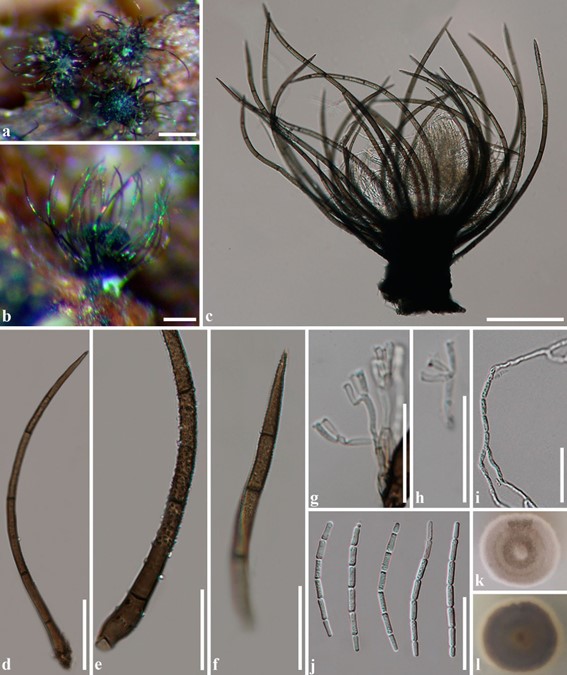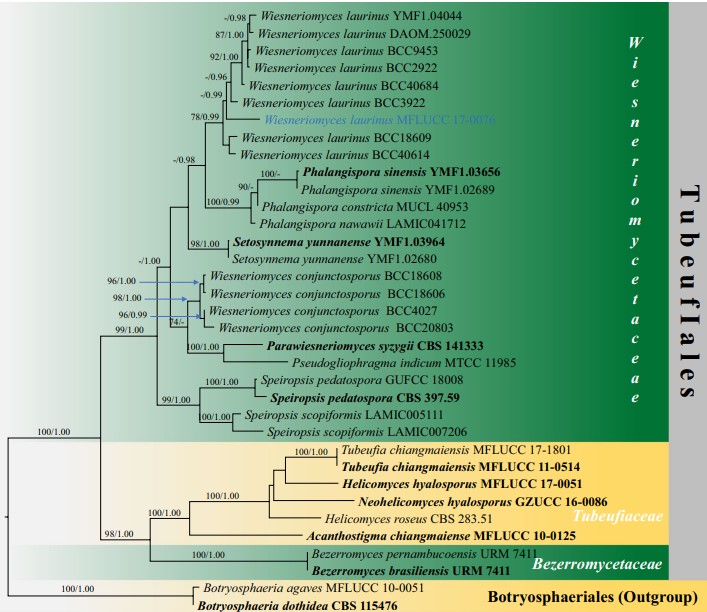Wiesneriomyces laurinus (Tassi) P.M. Kirk, Trans. Br. mycol. Soc. 82(4): 748 (1984).
MycoBank number: MB 107371; Index Fungorum number: IF 107371; Facesoffungi number: FoF 06313; Fig. 85
Saprobe, on bark of Hevea brasiliensis; Sexual morph: Undetermined. Asexual morph: Colonies 385–440 μm diam., on the substrate inconspicuous. Conidiomata sporodochial, superficial, solitary to gregarious, scattered. Setae 130–430 × 3–12 µm, arising from basal pseudostromatal stalk, straight or ± bent, abundant, dark brown to black, verruculose, 5–10-septate, tapering to subulate apex. Conidiophores 18–38 × 2–3 µm, macronematous, hyaline to subhyaline, smooth-walled, branched. Conidiogenous cells terminal, clavate to slightly inflated, hyaline, smooth-walled, 5.5–8.5 × 1.5–2.5 µm. Conidia [(4)5–7 cells], 46–67 × 2–4 µm, in chains, straight, long cylindrical, hyaline to subhyaline, aseptate, smooth-walled.
Culture characteristics: Conidia germinated on MEA within 12 hours and germ tube produced from one or both end or several cell of the conidia. Colonies on PDA reaching 4.5–5 cm diam. after 21 days at room temperature (20–25 °C), circular, effuse, velvety to hairy, initially white, becoming slightly radiating with greyish-brown concentric ring, white at the margin from above, dark grey to blackish at the center from below, with white circular edge.
Material examined: Thailand, Phayao Province, Muang, inner bark of Hevea brasiliensis (Euphorbiaceae), 5 December 2016, Senwanna C., RBPY019 (MFLU 18-1384; living culture MFLUCC 17-0076)
Sequence data: ITS: MN168764, LSU: MN168761, rpb2: MN174863, SSU: MN168759, tef1: MT050455.
Notes: During our study of microfungi on Para rubber in Thailand, a fresh specimen was obtained from inner bark of Hevea brasiliensis. The morphological characters of our fresh collection fit well with the description of W. laurinus (Suetrong et al. 2014, Chen and Tzean 2015). Based on our phylogenetic analysis of combined LSU and SSU sequence data, our strain groups with other W. laurinus strains with moderate bootstrap support (Fig. 86). Thus, this fresh collection is identified as W. laurinus.

Fig. 85 Wiesneriomyces laurinus (MFLU 18-1384, new host record). a, b Habit on substrate. c Conidioma. d Seta. e Base of seta. f Tip of seta. g, h Conidiophores. i Germinated spores. j Conidia. k Culture characteristic on PDA after 21 days (k = colony from above, l = colony from below). Scale bars: a–c = 100 µm, d–j = 30 µm

Fig. 86 Phylogram generated from maximum likelihood analysis (RAxML) of genera in Wiesneriomycetaceae based on ITS, LSU, rpb-2, SSU and tef1 sequence data. Maximum likelihood bootstrap values equal or above 70%, Bayesian posterior probabilities equal or above 0.90 (MLBS/PP) are given at the nodes. An original iso late number is noted after the species name. The tree is rooted to Botryosphaeria agaves (MFLUCC 10-0051) and B. dothidea (CBS 115476). The ex-type strains are indicated in bold. The new sequence is in blue. Hyphen (-) represents support values below 70% MLBS and 0.90 PP
